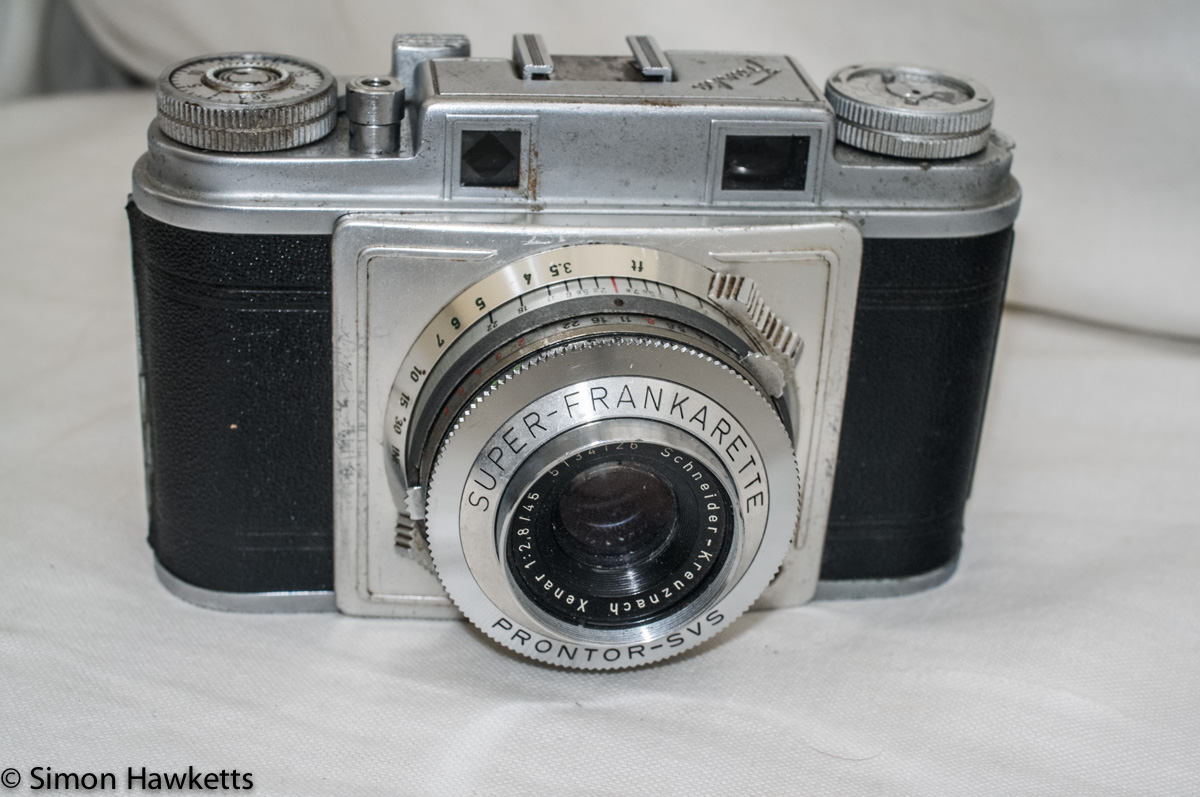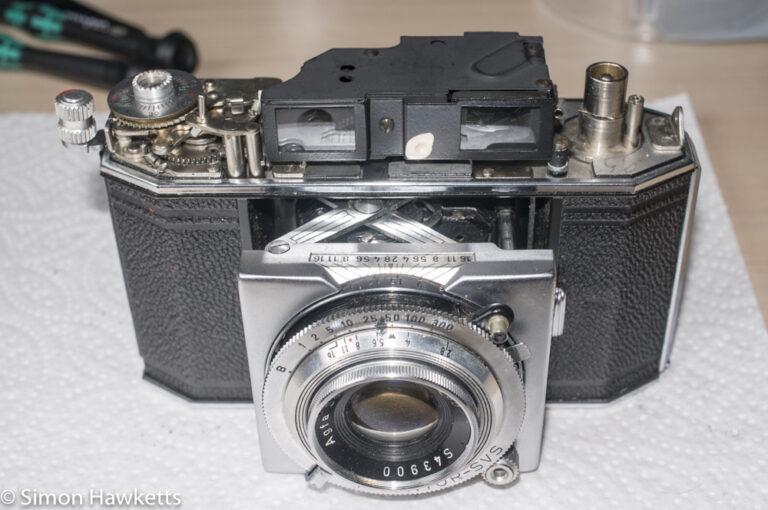The Super Frankarette Rangefinder camera from the late 1950s
The Super Frankarette rangefinder camera was made in Germany sometime in the late 1950s by the Franka company. It is the only camera I own by Franka, and they are one of the less common makes on the second hand camera market.
My Super Frankarette Camera
I’ve owned this camera for several years now. I originally bought it from eBay, and had to do a bit of work to get it into a working condition because the slow speed escapement was gummed up with old grease and dirt.
Once I’d made the repair, the camera got put back onto the back of a shelf, and I forgot about it, until the last few weeks when I’ve been clearing up and moving the whole camera collection into my new workshop / blogging room in the garden.
I can’t now remember how much I paid for the camera, but it wouldn’t have been much – probably a few pounds. I have to say that my example is not in the best condition; the top cover has several areas where there is rust starting to show, the aluminium parts are dull and have a sort of whitish powdery look to them and the front aluminium panel that the lens is mounted on is a bit scratched in places.
However, mechanically, the Super Frankarette is in pretty good shape. The shutter sounds crisp when it’s fired, the shutter speeds all work, and the aperture blades look quite clean.
The only problems mechanically are the focus control which is a little stiff, and the frame counter which seems completely wrong. The focus still works, and it doesn’t really warrant being taken apart to clean the mechanism yet, but it doesn’t quite feel right. I think the frame counter may be wrong because I’ve tried it without film in – it may need the film in place in order to correctly count.
Photos of the Super Frankarette










Description of the Super Frankarette
When I picked the Super Frankarette up a few days ago, I noticed that it looks like quite an inexpensive camera – which is a nice way of saying it looks cheap. The materials used are quite low quality and thin and don’t look as if they would stand up to a lot of hard wear.
The camera the Frankarette most reminded me of was one of the Edixa models, like the Edixa Mat, which also seemed to be built of quite thin, cheap materials.
It didn’t actually surprise me therefore, when I did a bit of research on the Franka company that a while after they produced this camera the company was purchased by Wirgin, who were the parent company that made the Edixa range of reflex cameras.
Having said that, the Super Frankarette, for all its failings in build quality, is actually quite a well specified camera for the time it was made.
The Exposure system on the Super Frankarette
The Exposure system for example uses the EV system of exposure control which is both easier for a novice photographer to use, and also, more complex to build into the camera. The EV system was a popular option in the mid to late 1950s and was used on many cameras to simplify the operation of taking a light reading and setting the camera to use that reading.

To use the EV system, the photographer would take a light reading using a light-meter that supported the EV system and from that they would obtain an EV number – let’s say it was 7.
The camera has a scale on the lens in red (shown in the picture here) which could be set by pressing the small button on the aperture scale and rotating it until the red arrow points to the number 7.
That meter reading of 7 corresponds to a number of different aperture/shutter speed combinations; it would be equally valid to use any of them, but each will give a subtle difference to the picture being taken. For example, when I set the Super Frankarette to EV 7, I can use any of:
- f/2.8 at 1/15th sec
- f/4 at 1/8th sec
- f/5.6 at 1/4 sec
- f/8 at 1/2 sec
- f/11 at 1 sec
If I use the f/2.8 option I will get quite a lot of background blur in my picture, but if I choose the f/11 option, most of the picture will be in focus. Obviously, the effect of the change in shutter speed can’t be ignored and must also be taken account of, but you get the idea I hope.
Once the EV value of 7 has been set on the camera, the different options can be freely selected by rotating the aperture / speed selection because they are locked together.
Focusing the camera
To assist with focusing, the Super Frankarette is fitted with a coupled rangefinder.
The rangefinder is a device which helps the photographer focus by showing two copies of the image in the centre portion of the viewfinder, which are only aligned properly when the subject is in focus.
So, for example, let’s assume you are taking a picture of a tree. When the camera is set to focus beyond the tree you will see, in a square in the centre of the viewfinder, the edge of the tree being offset to the right.
When the camera is set to focus in front of the tree, you will see in the same square that the edge of the tree is offset to the left.
It’s only when the focus is set absolutely correctly for the tree that the edge of the tree in that central square will properly align.
This is a system that is very easy to use once you get used to it – in fact, it is probably easier for most people to judge focus this way than with a through the lens SLR camera. Oh, by the way, although I said the central portion is a square, in the Super Frankarette it’s actually a small diamond shape in the middle of the viewfinder.
As well as having a rangefinder fitted, the Super Frankarette also couples that rangefinder to the focus control on the camera, which makes it particularly useful – some cameras had a rangefinder which just gave a reading which then had to be transferred to the camera.
Other features
The camera is fitted with a film type reminder on the top of the rewind shaft, which was useful to the photographer because it reminded them of the type of film they had fitted to the camera when it’s picked up several months after the last photo was taken. It is also useful to us today, because it gives little information about the type of film a photographer would be able to purchase in the mid to late 1950s.
There is a choice of Color T & Color K which is presumably for daylight colour film and tungsten light colour film (not sure which is which), and then a four different black & white film speeds, 25, 50, 100 and 200 ASA. Obviously the choice of film was somewhat limited1.
There is a frame counter dial on the top of the film advance but as I indicated above my version isn’t working, so I don’t know if it’s a count up or count down version.
The camera also has a tripod bush in the bottom and a flash sync socket on the front panel. The accessory shoe on the top of the camera is not equipped with a flash contact.
Franka Super Frankarette Specifications
- Franka Super Frankarette 35 mm rangefinder camera
- Prontor SVS shutter with speeds of 1 sec to 1/300 sec + bulb
- Schneider-Kreuznach Xenar 45 mm f/2.8 lens
- Aperture range f/2.8 to f/22
- Coupled rangefinder to assist with focus
- Flash sync socket
- Accessory socket
- Threaded shutter release for cable release
- Film type reminder on rewind knob
- Frame counter on film advance
- Tripod socket on base
- Serial No: 042648
- Lens Serial No: 5134126
- Manual available on-line here
- Interestingly the choice of film at the moment seems to be similarly limited – we are going on holiday soon, so I’ve been looking to buy some colour slide film and found that the Agfa CT100 I used to buy is no longer produced, and many other options are on very long delivery times [↩]
Discover more from Everything Vintage
Subscribe to get the latest posts sent to your email.




